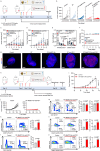Bioinspired ruthenium-manganese-oxygen complex for biocatalytic and radiosensitization therapies to eradicate primary and metastatic tumors
- PMID: 40819134
- PMCID: PMC12357870
- DOI: 10.1038/s41467-025-62999-x
Bioinspired ruthenium-manganese-oxygen complex for biocatalytic and radiosensitization therapies to eradicate primary and metastatic tumors
Abstract
Designing efficient, biocompatible radiation-sensitive materials to activate systemic immune responses can maximize tumoricidal effects against malignant tumors. Here, inspired by natural Mn-peroxidase, we propose the de novo design of the RuMn-oxygen complex (MnBTC-Ru) for biocatalytic and radiosensitization therapies to eradicate primary and metastatic tumors. Our results reveal that Mn-organic ligands can enhance the electron density of Ru clusters, thereby optimizing their binding to oxygen species and resulting in high reactive oxygen species and oxygen generation. Accordingly, MnBTC-Ru with radiation can enhance cell membrane and DNA damage, triggering apoptosis though oxidative damage, heightening radiosensitization, and activating CD8+ T cells. When combined with anti-PD-1 therapy, this synergistic approach generates robust systemic antitumor responses in female mice, promoting the abscopal effect and establishing enduring immune memory against tumors, thereby reducing recurrence and metastasis. This design presents superior biocatalytic and radiosensitizing properties, which may provide promising and practical bio-nanotechnology for future treatments on eradicating primary and metastatic tumors.
© 2025. The Author(s).
Conflict of interest statement
Competing interests: The authors declare no competing interests.
Figures







References
-
- Yi, K. et al. Engineered nanomaterials to potentiate CRISPR/Cas9 gene editing for cancer therapy. Adv. Mater.36, 2300665 (2024). - PubMed
MeSH terms
Substances
LinkOut - more resources
Full Text Sources
Other Literature Sources
Medical
Research Materials

